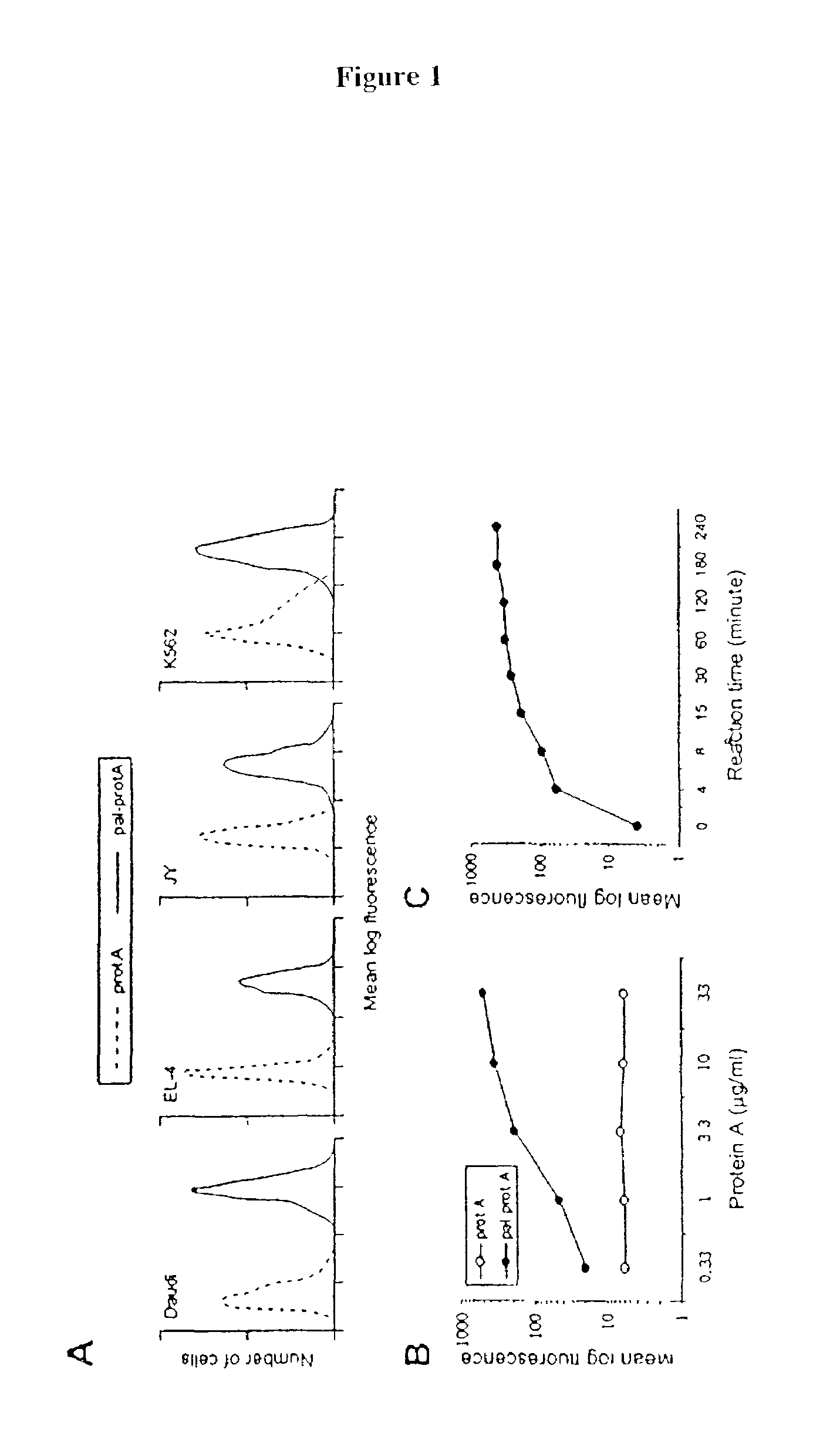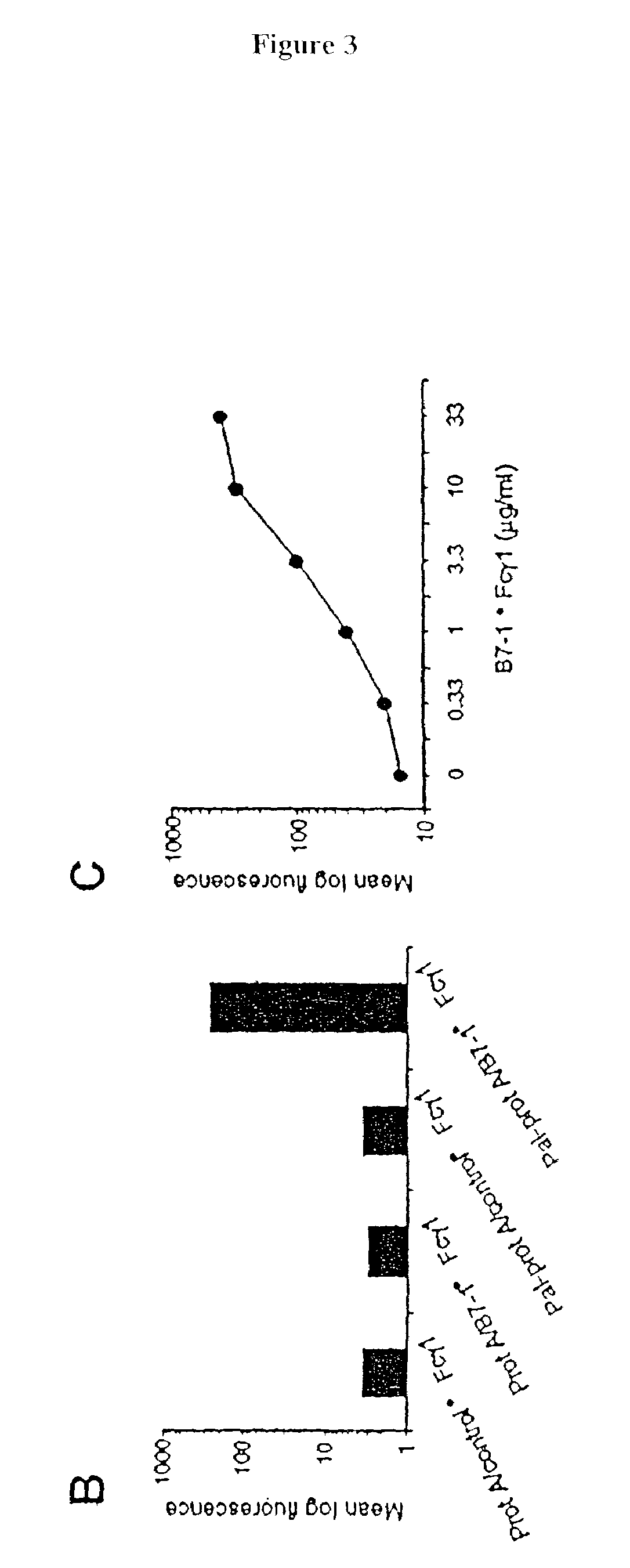Auto-stimulating cells and methods for making and using the same
a technology of auto-stimulating cells and cells, applied in the field of auto-stimulating cells and methods for making and using the same, can solve the problems of insufficient therapeutic benefit, toxicities of il-2, and inability to transfect apcs, including tumor cells, and the loss of activity of therapeutic t cells once injected into patients' bodies
- Summary
- Abstract
- Description
- Claims
- Application Information
AI Technical Summary
Benefits of technology
Problems solved by technology
Method used
Image
Examples
example 1
[0083]The following example demonstrates a method for transferring a B7-1•Fcγ1 fusion protein to a cell using palmitated protein A.
Palmitation of Protein A
[0084]Recombinant protein A (Calbiochem, La Jolla, Calif.) was derivatized with the N-hydroxysuccinimide ester of palmitic acid (Sigma, St. Louis, Mo.) as described by Kim and Peacock, J. Immunol Methods, 158:57 (1993). Briefly, a stock solution of the N-hydroxysuccinimide ester of palmitic acid was made, as was a solution containing protein A in a concentration of about 1.5 mg / ml. The solutions were mixed in a ratio of about 10 μg ester per ml protein and incubated at room temperature with constant mixing for about 18 h. The lipid-derivatized protein A was purified as described by Huang, et al., J. Biol. Chem., 225:8015 (1980) using a 30-ml Sephadex G-25 (Sigma) column. The protein product, referred to herein as “pal-prot A∘, was quantitated using a bicinchoninic acid kit (Bio-Rad, Richmond, Calif.), filter sterilized, and stored...
example 2
[0103]The effect of temperature on membrane-incorporated protein A was studied; the transferred protein must remain cell-bound in vivo in order to prime T-cells, which requires stable engagement of costimulators for at least several hours. It was determined that the reaction temperature at which a lipidated protein is transferred to the cell membrane has a major impact on long-term retention of the protein on the membrane. Protein transfer reactions were performed at 4° C., 25° C. or 37° C.; palmitated protein A was transferred onto K562 cells. An hB7-1•Fc was 125I-labeled and transferred to the protein A-coated cells in the manner described in Example 1. To prevent interference of endocytosis likely to occur at temperatures above 4° C., the cells were treated with the metabolic inhibitors sodium azide and 2-deoxyglucose prior to the transfer reaction.
[0104]To determine the long-term retention of the transferred protein on the cell membrane, the cells were thoroughly washed to remov...
example 3
[0105]C3H / HeN mice, purchased from Harlen (USA), Indianapolis, were immunized with a cell vaccine generated from the T-50 cell line, obtained from Avranham Hochberg, Hadassah University Hospital. The vaccine was prepared following the procedure generally outlined in Example 1, using palmitated protein A and nB7-1ωFc, m4=1 BBL•Fc, and hCD40L•Fc fusion proteins. Basically, the cells were coated with the lipidated protein A at 37° C. at a ratio of 40 μg protein A per 40×106 cells. The cells were then incubated at 4° with an equal mixture of the three fusion proteins at a ratio of 20 μg total protein per 4×107 cells. The cell vaccine was injected into the mice subcutaneously at a dose of 106 cells per injection. The injections were given once a week and continued for three weeks. One week after the last injection, the animals were challenged with 106 wild-type T-50 tumor cells, injected intradermally on the rear flank. As FIG. 9 shows, the cell vaccine improved the survival rate of the ...
PUM
| Property | Measurement | Unit |
|---|---|---|
| concentration | aaaaa | aaaaa |
| concentrations | aaaaa | aaaaa |
| density | aaaaa | aaaaa |
Abstract
Description
Claims
Application Information
 Login to View More
Login to View More - R&D
- Intellectual Property
- Life Sciences
- Materials
- Tech Scout
- Unparalleled Data Quality
- Higher Quality Content
- 60% Fewer Hallucinations
Browse by: Latest US Patents, China's latest patents, Technical Efficacy Thesaurus, Application Domain, Technology Topic, Popular Technical Reports.
© 2025 PatSnap. All rights reserved.Legal|Privacy policy|Modern Slavery Act Transparency Statement|Sitemap|About US| Contact US: help@patsnap.com



